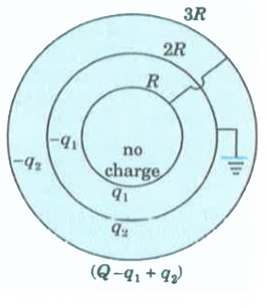InterviewSolution
Saved Bookmarks
| 1. |
There are three concentric metallic spherical shells of radius R, 2R and 3R. Charge Q is given to the innermost spherical shell. If the innermost spherical shell is connected with a metal wire to the outermost spherical shell without touching the middle shell, which is connected to the earth, then, find charges appearing on all surfaces. |
Answer» Solution :If we read the question carefully then we get to know that charge distribution is to be done in a way that NET charge outermost spheres TOGETHER is Q, and electric potential of middle sphere is equal to zero because it is connected to the earth.  Let us start with the innermost sphere. There should not be any charge on INNER surface of this sphere because there is no electric field inside it. Let us assume that `q_(1)` charge appears on outer surface of the innermost sphere then we know that charge on inner surface of middle sphere of has to be `-q_(1)` DUE to electrical constraint of metallic surfaces facing each other. Now we know that the middle sphere is connected to the earth. Hence, it is not isolated. Let us assume that `q_(2)` charge appears on the outer surfaceof the middle sphere, then again due to electrical constraint charge on inner surface of outermost sphere has to be `-q_(2)`. Now charge on the outer surface of the outermost sphere is `(Q-q_(1)+q_(2))` so that the totalcharge on innermost and outermost spheres together remains Q. Electric potential of the innermost sphere is equal to the outermost sphere because thetwo are connected to each other by a metallic wire so charge on them mustensure same potential on them. We get the following equation: `V_("inner-most")=V_("outer-most")` `(q_(1))/(4pi epsilon_(0)(R ))+(q_(2)-q_(1))/(4pi epsilon_(0)(2R))+(Q-q_(1))/(4pi epsilon_(0)(3R))` `=(q_(1))/(4pi epsilon_(0)(3R))+(q_(2)-q_(1))/(4pi epsilon_(0)(3R))+(Q-q_(1))/(4pi epsilon_(0)(3R))` `rArr 6q_(1)+3q_(2)-3q_(1)=2q_(1)+2q_(2)-2q_(1)` `rArr 3q_(1)=-q_(2) rArr q_(1)= -(q_(2))/(3)"" ...(i)` The middle sphere is earthed and hence its electrical potential is zero. We get the followingequation: `V_("middle-sphere")=(q_(1))/(4pi epsilon_(0)(2R))+(q_(2)-q_(1))/(rpi epsilon_(0)(2R))+(Q-q_(1))/(4pi epsilon_(0)(3R))=0` `rArr (q_(2))/(4pi epsilon_(0)(2R))+(Q-q_(1))/(4pi epsilon_(0)(3R))=0` `rArr 3q_(2)+2Q-2q_(1)=0` `rArr 2q_(1)-3q_(2)=2Q "" ...(ii)` Now substituting value of `q_(1)` from equation (ii) we get the following: `rArr 2((-q_(2))/(3))-3q_(2)=2Q rArr (2q_(2))/(3)+2q_(2)= -2Q` `rArr (11)/(3) q_(2)= -2Q rArr q_(2)= -(6)/(11)Q "" ...(iii)` Substituting value of `q_(2)` from equation (iii) in equation (i) we get the following: `rArr q_(1)=(2)/(11)Q "" ...(iv)` Now the charge on outer surface of the outermost sphere can be written as: `Q-q_(1)+q_(2)` `Q-q_(1)+q_(2)=Q-(2)/(11)Q-(6)/(11)Q=(3Q)/(11)`. Now we have CHARGES on all surfaces. Charge on inner surface of the innermost sphere: 0 Charge on outer surface of the innermost sphere: `2Q//11` Charge on inner surface of the middle sphere: `-2Q//11` Charge on outer surface of the middle sphere: `-6Q//11` Charge on inner surface of the outermost sphere: `6Q//11` Charge on outer surface of the outermost sphere: `3Q//11` |
|